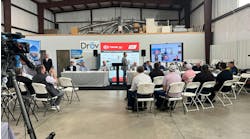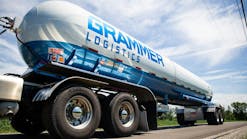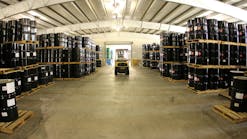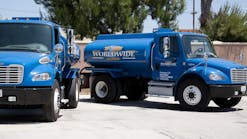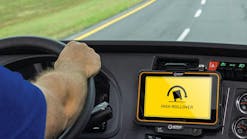Cameras are ubiquitous in today’s commercial vehicles. Most carriers spec outward-facing cameras, many are upgrading to multi-camera setups, and even inward-facing dashcams are gaining acceptance with drivers. But executives hoping to win a safety championship may have to point a camera at themselves.
That’s how Trimac Transportation recorded its third Heil trophy three years ago.
As part of the tank truck carrier’s Rooted in Safety overhaul in 2019, company leaders not only implemented Lytx’s video safety system, they also stopped pointing fingers at drivers and started asking what they could do better as managers to keep drivers safe—and even installed cameras in all management vehicles.
“They really put their money with their mouth is,” said Jeff Martin, Lytx vice president of global sales strategy.
“That’s leading by example.”
Lytx, founded in 1998 in San Diego, California, recently highlighted Trimac’s award-winning safety improvement in a webinar featuring Alex Guariento, Trimac vice president of safety; Lance Hagler, Trimac director of safety and security; Ryan Brandos, Lytx senior key account executive; and Martin, who joined the telematics giant in August 2022 after serving the previous 13 years as VP of Waste Management Safety Services.
According to an executive summary, Trimac decreased lost-time injury rates by 40% by using Lytx DriveCam event recorders as tools to reinforce good driving habits and focusing on eliminating “high-consequence” events—those that result in a fatality, life-changing injury, or loss of $100,000 or more—in a deep dive that also revealed 85% of incidents were management-related failures. “Eighty-five percent of the time, when something serious occurs, it is because we as an organization contributed to it,” Guariento confirmed.
Program realignment
Trimac garnered the 2002 and 2007 North American safety championships back when National Tank Truck Carriers still awarded only one Heil trophy. Leaders said Trimac’s success starts with good people and processes when discussing the second award, and then-CEO Jeff McCaig—who now serves as Trimac board chairman—insisted the company’s commitment to safety “truly makes us stand out from the competition.”
See also: Trimac, G&D/Hoffman secure prestigious Heil trophies
But a decade later, a once-great differentiator began to diminish, and increasing Department of Transportation (DOT)-recordable accidents rates in 2018 finally forced Trimac to reimagine its approach to safety. Two years later, they won a third Heil trophy with an accident frequency of .681 in the 2019 Competitive Safety Contest. Now-retired VP of Safety Robert Beach credited Trimac’s employees for embracing “significant” change, including launching a new safety program, hiring more safety experts, coaching high-risk drivers, improving incident investigations, and developing employee-vetted procedures and training materials.
“Tactically, our senior management supported the doubling of our salaried field-level safety professionals, and we changed their focus from being auditors to being coaches and trainers, which really helped improve the trust levels of our employees, along with the results we’re getting,” he said in a Sept. 22, 2020, webcast.
“We embraced a socio-technical safety system that moved our focus away from looking at industry-standard, lagging indicators and replaced it with a focus on leading indicators heavily centered around our employee reporting.”
Rallying around safety
Martin, who implemented Lytx’s video safety system for Waste Management, called Trimac’s story a great example of how a company achieves a “total value realization” by making safety foundational in its pursuit of operational excellence. “They recognized they were good at safety, but they weren’t good enough,” he told Bulk Transporter. “People were still getting hurt, and they were still experiencing catastrophic losses.”
To help eliminate high-consequence events, managers adjusted their thinking, going from making at-fault determinations to asking what role they played in every situation. “They changed the way they look at incidents,” Martin said. “Instead of focusing solely on outcomes, they started looking at contributing factors and framework. What put the driver in a position where they had to make a tough decision?” The question led to new stop-work authority for drivers, who aren’t punished for reporting hazards—even those they caused.
See also: Trimac executes fourth acquisition this year
DriveCams also enable real-time self-correction and “recognition events,” in which drivers are praised for positive actions, and promote consensus between managers and drivers by capturing 4 seconds before and 8 seconds after an incident to “tell a better story” that allows for post-incident reflection. “The hammer-down approach just doesn’t work with today’s drivers,” Martin said. “And it doesn’t work in the management ranks either.”
Uniting for everyone’s safety, however, works wonders, Martin insisted. Constructive conversations between drivers and managers tend to spread across all departments, opening dialogues that improve operational efficiencies. “Many companies we serve today are taking that coaching model and applying it not only to safety and telematics, but how to bolster customer service, how they can better dispatch, and how they can optimize their fleet shops,” he said. “So it’s changing the dynamics—and that’s exciting.
“When people rally around the moral imperative of saving lives and dreams, they start to build momentum, and anything is possible.”
Saving lives
Trimac skipped a trial period, opting to go all in from the outset. The carrier later upgraded its SV2 cameras to Lytx DriveCam MV+AI (machine vision plus artificial intelligence) cameras, while also building out multi-camera setups. But companies that choose to trial the system are assigned a success manager who works with managers, drivers, and support staff, typically across a three-month period, Martin said. “It’s common for people to come out of the trial saying, ‘Let’s go’ because they see behaviors changing,” he attested.
Tank truck carriers are chief among them, Martin added.
“We have a major focus on field-service companies like Trimac,” he said. “I refer to those people as industrial athletes because they aren’t just long-haul drivers. They’re out there performing many different tasks. So the video safety and telematics solutions Lytx provides are very popular with those types of companies.”
Most take a phased approach to rollout, acclimating drivers to the verbal alerts, and configuring priorities and procedures for several weeks before coaching commences. Fleets typically see behaviors changing within 60-90 days, Martin said, leading to life-saving decreases in the frequency and severity of accidents. “We also provide the training, including ‘train-the-trainer’ sessions, and materials,” he added.
And by working together, companies can expose “layers of risk” they never knew existed, better protecting themselves and drivers from metastasizing legal settlement sizes and increasingly “significant” verdicts, like the recent 30-year sentence handed to a driver for vehicular homicide in Florida’s first cell phone-related distracted driving case.
“Simply stated, knowing the Lytx team is helping partners save lives and dreams is rewarding beyond words,” Martin concluded.

